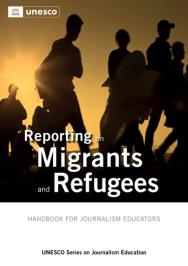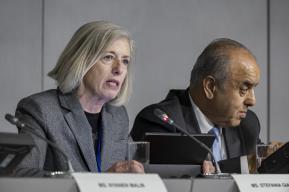Article
UNESCO launches must-read handbook on reporting on migrants and refugees

As the world commemorates World Press Freedom Day 2022, Ukraine and Ukrainians struggle with the war that has now been raging for more than two months. The invasion of Ukraine has created the largest refugee crisis of modern times. The UN has declared Ukraine a level 3 emergency, the highest level there is.
Over 12 million people have been forcibly displaced since 24 February 2022. Over five million refugees are estimated to have fled across borders, and over seven million people are estimated to be internally displaced in Ukraine.
Worldwide, 281 million people are counted as migrants and almost 83 million people are forcibly displaced. Ukraine, Afghanistan, Syria and Venezuela, Ethiopia, South Sudan and Iraq are among the ten largest refugee crises in recent times, bridging Africa, Asia, Latin America and Europe in woeful commonality.
It is being taken as granted that journalists are on the ground to report and contextualize the breaking news associated with such developments. However, they are not always free to do so - that is why World Press Freedom Day merits being commemorated.
Further, many journalists are not always given the chance of quality education to live up to their demanding assignments in reporting human displacement.
When conflict converts civilians into refugees, media professionals are also charged with reporting on these key actors, often without training in how to accurately and sensitively report on refugees and migrants. The Handbook for Journalism Educators: Reporting on Migrant and Refugees addresses this curricular dearth.
Published by the UNESCO, researched and edited by Susanne Fengler, Monika Lengauer and Anna-Carina Zappe from the Erich Brost Institute of International Journalism (EBI) at TU Dortmund University, it fills the knowledge gap and provides a resource for journalism educators worldwide. The handbook is interdisciplinary and cross-cultural.
It addresses journalism educators, students, practitioners, globally in universities and newsrooms. In thirteen chapters, it offers basic knowledge, recommends databases, discusses reasons and impacts of migration and forced displacement, deals with trauma-sensitive reporting, the ethics of reporting on migrants and refugees, and on marketing strategies.
Guy Berger, secretary to UNESCO’s International Programme for the Development of Communication (IPDC) at UNESCO, values the handbook as “a very substantive tome and a milestone in supporting educators to prepare journalists for quality reporting, particularly in today’s unprecedented flows of disinformation”.
The handbook mainly attempts to tell the African story of migration, and it involves local scholars and journalists to give an account of migration in African countries, within the continent and from the continent. This reiterates that migration is truly global, and so is our outlook. The handbook unfolds migration and forced displacement not only in Africa and Europe but it also leads to scholarly insights from the Arab World, the Americas, Asia, and Eastern Europe.
Monica Chibita, Dean of the School of Journalism, Media and Communication at Uganda Christian University, in Kampala, Uganda, appreciates the textbook as a “one-stop point of comprehensive information, resources, tips and cases that imparts knowledge and skills based on a multi-disciplinary and multi-cultural approach”.
Verica Rupar, Chair of the World Journalism Education Council (WJEC) and Professor of Communication at Auckland University of Technology (AUT), New Zealand, deems the handbook “the most valuable material on the subject for journalism educators across the world”.
Nadia Vissers, Director of the European Journalism Training Association (EJTA) and International Coordinator and lecturer AP University College, Antwerpen, Belgium, particularly appreciates the “hands-on parts of the handbook - the didactics, classroom exercises, assignments, the recommended reading - that break the foundational theory down to the needs of the classroom and the newsroom”.
Another testimony comes from Will Vassilopoulos, video journalist at the Agence France-Presse (AFP). Based in Athens, Greece, he has a long track covering conflict, forced displacement and migration. He reported from Ukraine in the buildup to the war and covered the refugee crisis at the Ukrainian-Polish border. He recalls his eye-witness reports of migrants and refugees in unseaworthy boats struggling for life in the Mediterranean Sea. On the occasion of World Press Freedom Day 2022, Will Vassilopoulos elaborates on the relevance of the handbook:
This handbook provides invaluable information on an array of topics that I found very useful while reporting extensively on the migration crisis in the Mediterranean and most recently the unprecedented refugee crisis at the Polish-Ukrainian border. It is an excellent reference handbook that every journalist must read before leaving on an assignment that deals with migrants and refugees.
The editors invited 30 co-authors from across the globe to contribute their specific cultural experiences to the handbook, making it appropriate to different journalism cultures. As well, they offer it in open-source format, allowing easy access and universal usage. The handbook is currently available in English, and will soon be ready to use in Arabic, French, Spanish and Kiswahili. It was produced with the support of UNESCO’s International Programme for the Development of Communication (IPDC).








